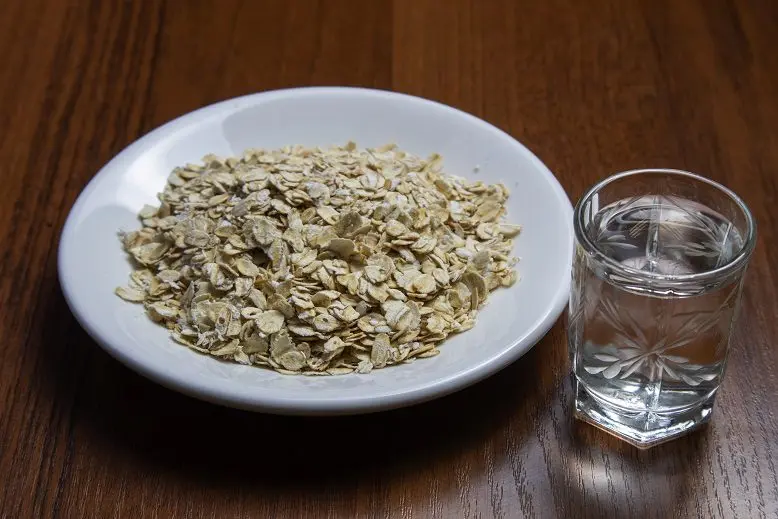Oat moonshine is remembered for its mild taste and subtle cereal aroma. The cooking technology is standard, but the yield is less than from barley and wheat.
Theory
Regardless of the condition (grain, cereals, flour, flakes), oats contain starch, which must be broken down to sugar before fermentation, otherwise the mash will not ferment, since yeast can only process simple sugars into alcohol.
There are two ways to break down starch: with malt (classic hot saccharification) and with the help of enzymes (cold saccharification). Each method has both advantages and disadvantages. The universal method for setting the mash on enzymes is discussed in a separate article, but here we will make moonshine from oats in the classic way, saccharifying starch with malt (sprouted grain).
The theoretical yield from 1 kg of oats is 0,672 liters of moonshine with a strength of 40%. The distillate obtained from malt must also be taken into account – 1 kg of barley malt additionally increases the yield by 0,84 liters (40% vol.). Adding sugar to the mash allows you to further increase the amount of the drink – 1 kg gives 1,2 liters of forty-degree distillate, but sugar makes the aroma and taste of oatmeal moonshine not so bright, so it’s better to get by with only grain (flour, flakes) and malt. Due to losses during distillation, the actual yield of moonshine from oats will be 10-15% lower than theoretical values.
The choice of malt is not of fundamental importance: store-bought or homemade, green or dried is suitable, in addition to barley, you can use rye or wheat, or even germinate part of the oats at home.
The optimal proportion is 4:1 (for 4 parts of unsprouted grains, cereals or flour, take 1 part of malt). In total, 1 liters of water should fall on 5 kg of grain raw materials.
Attention! It is very important to adhere to the temperature values uXNUMXbuXNUMXbspecified in the recipe, otherwise the oats will not sugar. For control, it is desirable to have an electronic thermometer.
Ingredients:
- oats (whole, cereals, flour, herculean flakes) – 4 kg;
- malt (preferably barley) – 1 kg;
- sugar – 0,5-1 kg (optional);
- water – 25 liters (and 4 liters for each kilogram of sugar);
- yeast – 20 grams dry or 100 grams pressed.
Oatmeal recipe
1. Grind oats and malt to a coarse grain.
2. Heat water (4 liters per 1 kg of raw materials and malt) in the brewing vessel to +50-55 °C. Slowly add grits (flour), do not use malt. Stir so that the mass does not clump. The brewing vessel can be filled up to a maximum of 70%.
3. Heat the mixture to +60 °C, cook for 15 minutes, stirring occasionally, then bring to a boil and cook for 50-90 minutes until a homogeneous porridge-like mass is obtained. The longest time is to cook cereals, less – flour and oatmeal flakes.
4. Cool the finished porridge to + 63-68 ° C. Gradually add malt, stirring constantly. It is very important that there are no lumps.

5. Heat the porridge to + 63-68 ° C, cover the pan with a lid. Periodically heating the container, maintain the specified temperature for 2 hours. During the first hour, mix twice with an interval of 30 minutes.
After successful saccharification, the porridge should become sweet.
6. Add sugar (optional) and the remaining water (1 liter per 1 kg of grain raw materials and 4 liters per 1 kg of sugar) to the finished wort. Mix. It is desirable that the water be very cold.
7. Cool down the wort to +25-28°C as soon as possible, for example by immersing the pan in a bath of cold water or ice.

8. Pour the wort into a fermentation tank. Pour activated yeast according to label instructions. Install a water seal of any design on the neck of the fermentation tank (you can use a glove with a hole in one of the fingers). Put the mash in a dark place at room temperature.
Depending on the yeast and the temperature, the oat mash (hercules) ferments for 3-10 days, then it becomes bitter in taste without notes of sweetness, the water seal stops emitting gas (the glove deflates), and a layer of sediment appears at the bottom. This means that you can start distillation.
Obtaining moonshine from oats
9. Drain the oatmeal wash from the sediment, otherwise the solid part may burn during the heating process, ruining the taste. You can not filter only when steam distillation.
10. Overtake the mash at maximum speed without separation into fractions. Finish selection when the strength in the jet falls below 20%. The drink may turn cloudy – this is normal.
11. Determine the amount of pure alcohol – multiply the strength in percent by the volume in liters and divide by 100.
12. Dilute oatmeal moonshine with water to a strength of 18-20% and overtake again. Collect the first 10-12% of the yield of pure alcohol separately. This harmful fraction (“heads”) can only be used for technical needs.
13. Collect the main product (“body”) until the strength in the jet falls below 45%, then complete the selection or select the “tails” separately.
14. Dilute the resulting moonshine from oats (“body”) to a drinking strength of 40-45%, pour into glass containers and seal tightly. Before tasting, leave in the refrigerator for 2-3 days to stabilize the taste after mixing with water.










